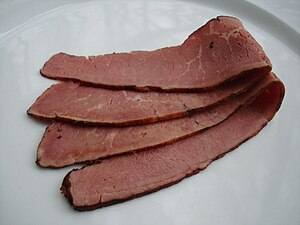Corned Beef Pastrami and Tongue Sandwich Calotkes


Pastrami (Romanian: pastramă) is a food originating from Romania usually made from beef brisket, and sometimes from lamb, or turkey. The raw meat is brined, partially dried, seasoned with herbs and spices, then smoked and steamed. Like corned beef, pastrami was originally created as a way to preserve meat before the invention of refrigeration. One of the iconic meats of Romanian cuisine as well as American Jewish cuisine and the New York City cuisine, hot pastrami is typically served at delicatessen restaurants on sandwiches such as the pastrami on rye.
Etymology and origin [edit]
The name pastrami comes from Romanian pastramă, a conjugation of the Romanian verb a păstra meaning "to preserve food, to keep something for a long duration" whose etymology may be linked to the Turkish pastırma, possibly from Turkish: bastırma [1] [2] [3] [4] It is sometimes claimed that the name pastirma comes from Greek παστρον "dried meat."[ citation needed ]
Wind-dried beef had been made in Anatolia for centuries, and Byzantine dried meat is thought by some to be "one of the forerunners of the pastirma of modern Turkey."[5]
Early references in English used the spelling "pastrama", closer to the Romanian pastramă. Pastrami was introduced to the United States in a wave of Jewish immigration from Bessarabia and Romania in the second half of the 19th century. The modified "pastrami" spelling was probably introduced in imitation of the American English salami.[6] Romanian Jews emigrated to New York as early as 1872. Among Jewish Romanians, goose breasts were commonly made into pastrami because they were available. Beef navel was cheaper than goose meat in America, so the Romanian Jews in America adapted their recipe and began to make the cheaper-alternative beef pastrami.[7]
New York's Sussman Volk is generally credited with producing the first pastrami sandwich in the United States in 1887. Volk, a kosher butcher and New York immigrant from Lithuania, claimed he got the recipe from a Romanian friend in exchange for storing the friend's luggage while the friend returned to Romania. According to his descendant, Patricia Volk, he prepared pastrami according to the recipe and served it on sandwiches out of his butcher shop. The sandwich was so popular that Volk converted the butcher shop into a restaurant to sell pastrami sandwiches.[8] [ additional citation(s) needed ]
Preparation and serving [edit]

Beef plate is the traditional cut of meat for making pastrami, although it is now common in the United States to see it made from beef brisket, beef round, and turkey. New York pastrami is generally made from beef navel, which is the ventral part of the plate.[9] It is cured in brine, coated with a mix of spices such as garlic, coriander, black pepper, paprika, cloves, allspice, and mustard seed, and then smoked. Finally, the meat is steamed until the connective tissues within the meat break down into gelatin.[10]

Greek immigrants to Salt Lake City in the early 1960s introduced a cheeseburger topped with pastrami and a special sauce. The pastrami cheeseburger has since remained a staple of local burger chains in Utah.[11]
See also [edit]
- Bündnerfleisch
- Pastırma – Spiced dried beef from the Middle East
- Pastramă
- List of dried foods
- List of smoked foods
- Montreal-style smoked meat – Style of smoked meat corned beef created by Jewish immigrants in Montreal, Quebec
- Corned beef – Salt-cured beef product
- Pastrami on rye
-
 Food portal
Food portal
References [edit]
- ^ Oxford English Dictionary, 3rd Edition, 2005, s.v. 'pastrami'
- ^ Andriotis et al., Λεξικό της κοινής νεοελληνικής
- ^ Babiniotis, Λεξικό της Νεας Ελληνικής Γλώσσας
- ^ "pastırma". www.nisanyansozluk.com . Retrieved December 7, 2017.
- ^ Dalby, Andrew (April 15, 2013). Siren Feasts: A History of Food and Gastronomy in Greece. Routledge. p. 189. ISBN978-1-134-96985-2.
- ^ Harry G. Levine, "Pastrami Land, a Deli in New York City", Contexts, Summer 2007, p. 68
- ^ "Historical Fact - The Origins of Pastrami". Romania Tourism . Retrieved August 31, 2015.
"Goose-pastrama" was the starting point for American pastrami. The Jewish immigrants who settled in Little Romania brought with them a traditional technique for preserving goose by salting, seasoning, and smoking the meat. In America, however, beef was cheaper and more widely available than goose, so pastrama was made with beef brisket instead. Later the name became pastrami—perhaps because it rhymed with "salami" and was sold in the same delicatessens. By the time Little Romania dispersed in the 1940s, New Yorkers from every ethnic background were claiming expertly sliced pastrami as their rightful heritage.
{{cite web}}: CS1 maint: url-status (link) - ^ Moscow, Henry (1995). The Book of New York Firsts . Syracuse University Press. p. 123. ISBN9780815603085.
pastrami sandwich origin.
- ^ Marks, Gil (November 17, 2010). Encyclopedia of Jewish Food. Wiley. ISBN9780470943540.
- ^ Earl, Martin. "How to Make Smoked Pastrami". Retrieved September 27, 2021.
- ^ Edge, John T. (July 28, 2009). "Pastrami Meets Burger in Salt Lake City". The New York Times. ISSN 0362-4331. Retrieved December 7, 2017.
| | Wikimedia Commons has media related to Pastrami. |
houstonthounfor1944.blogspot.com
Source: https://en.wikipedia.org/wiki/Pastrami
Post a Comment for "Corned Beef Pastrami and Tongue Sandwich Calotkes"